Is there a more sublime tool then the Swiss army knife? Is there any tool more useful? I don’t think so. The iconic Swiss army knife has accompanied generations upon generations of soldiers, workers, campers, hikers and adventurers afield, allowing them to keep a useful variety of common tools close at hand in their pockets or on their belts while adding very little to their overall load.
The elegance, simplicity and sheer handiness of the Swiss army knife puts many other tools to shame, and I will always choose one of these lean and lightweight beauties over the bulky and vulgar multiplier tools that we are saddled with today. But no matter how good any tool is, no matter how useful, it will have some drawbacks.
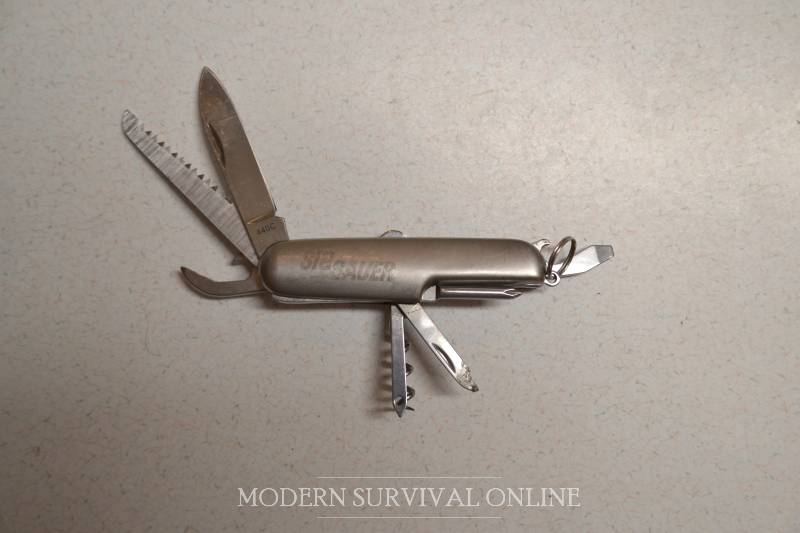
The drawback of the Swiss army knife and other copycat knives like it is that they are not easy to keep clean owing to type tolerances and a closely crowded interior.
Swiss army knife owners are familiar with the frustration and irritation that accompanies trying to get one of these small knives truly clean. A task that is cursory at best with other knives is turned into a frustrating puzzle with these multifunction blades.
But you don’t have to tear your hair out or go crazy trying to get your Swiss army knife clean if you follow the seven simple steps we will provide for you in the article below. By the end, your Swiss army knife will be shining like a new penny.
They Are Harder to Clean Than You Think
If you are not a Swiss army knife owner (or if you are an owner and have never bothered to properly clean your knife) you might be wondering what all the fuss is about.
Surely I am exaggerating. Surely I am overstating what is in reality a trivial task. Right? Wrong.
Swiss army knives are a challenge to clean, or at least a challenge to clean if you don’t want to make your life even harder by disassembling it, assuming that it can be easily disassembled.
The root of the difficulty lies within the tight tolerances and compact form factor of the knife’s interior.
Most genuine Swiss army knives and clones of any quality will cram in as many tools as possible into the highly limited space of the interior. This crowding provides many nooks, crannies and hiding places for dirt, sand, grit, lint and debris.
The fastidious owner will no doubt declare that this is precisely why the knife needs to be disassembled and detail cleaned. But taking that approach will so often go terribly wrong.
Your Swiss army knife is probably easy enough to get apart but can be infuriatingly difficult to get back together properly.
Even those owners who do manage the task without damaging anything often report that tools now open or close with a worrying degree of slop or, worse yet, lose the opening and closing tension that provides confidence while in use.
This leaves us at something of a fork in the road: detailed disassembly can make our lives even harder, but forgoing disassembly might mean that we will never get our knives truly clean. Do we need to take our Swiss army knife apart to clean it properly or not?
To Disassemble or Not
Bottom line up front: I do not think you need to fully disassemble any Swiss army knife or clone to properly clean it. In fact, the only part of your knife that I would have you take apart is the exterior scales, or handle slabs.
On that note, not every Swiss army knife has scales that can be easily removed. Some are riveted on, and this approach is increasingly common on the many clones that are on the market, with some even featuring a “unibody” construction where the frame and handle are made of one piece or turned into one piece by welding or some other attachment method.
If your Swiss army knife scales cannot be easily or safely removed or if your knife does not have any scales or slabs at all, don’t worry about it. Simply omit any mention of removing them in the steps below, and do the best you can with the rest of the steps. It will work out fine, I promise.
Don’t Clean Your Swiss Army Knife with the Following
Before we get to my preferred method for cleaning a Swiss army knife, it might be instructive to go over the lackluster methods for cleaning.
Regrettably, sometimes the internet does not make the most effective methods the most visible, and has instead served to propagate jackleg or amateurish methods of cleaning that will do a bad job, damage or otherwise impair the function of your knife.
Maybe you have heard of these methods and maybe you haven’t, but whether you are familiar with them or not you should omit the use of any of them for cleaning your Swiss army knife.
 Harsh Chemical Cleaners
Harsh Chemical Cleaners
There are a variety of harsh chemical cleaners on the market that seem like they would be the perfect solution to both flushing and cleaning the cramped, difficult interior of the average Swiss army knife.
From pressurized bore cleaner used on firearms to the ubiquitous and caustic brake cleaner that can be found in every home workshop, there is no shortage of seeming wonder solutions you might call upon for cleaning your Swiss army knife.
Invariably, almost all of them fall well short of what you need. For starters, most of these chemicals are entirely too harsh to be used on the fine steels, plastics, and woods present on most Swiss army knives.
Second, more than a few of them will actually promote corrosion and you’ll have no way to get the residue out of all those little nooks and crannies after you blast out the interiors. Avoid these chemicals if you are wise.
 WD-40 / All-in-One Treatments
WD-40 / All-in-One Treatments
All-in-one rust removers, water displacers and lubricants are another seemingly ideal solution for giving your Swiss army knife a little TLC.
WD-40 in particular is a fixture in every toolbox and tool bag across America, and I have little doubt that your grandpa sang its praises to you, as mine did to me. Unfortunately, WD-40 and other similar products fall well short of what we need.
The reason is simple: they are all poor lubricants.
While they work well enough for flushing water out of all of the many hiding places inside our SAKs, the film they leave behind will comparatively quickly congeal into a thick grease that will impair function and actually lock grit, dust and sand in place, promoting wear.
If what we are using is a poor lubricant and can actually make things worse going forward, why would we use it at all?
 Dishwasher
Dishwasher
The crowning horror that you could subject your Swiss army knife to for routine cleaning would be simply popping it in the dishwasher (hopefully in the silverware basket with all the other knives you mistreat).
Believe it or not, and I’m not kidding, I actually see this method floated more often than not in my travels around the internet. I am not sure how this idea got started, and I am further puzzled at how it took hold, but it persists.
The notion, I would suppose, is that the high pressure spray of soapy water inside the dishwasher would prove more than adequate for blasting the grease and grime out of your Swiss army knife.
If it can remove tough, baked on lasagna, it can surely remove that, right? I am sure it can, but it will be extremely hard on your knife in the bargain.
Dishwasher detergent is very harsh and will often rust fine steels. Don’t subject your Swiss army knife to a trip through the dishwasher.
The Steps
Okay, so we learned how we definitely should not clean our knives, now it is time to learn the proper way.
The method I will share with you below is one that I have employed for years with all types of Swiss army knives, both from major manufacturers and unknown importers. So long as you are diligent and just a little bit cautious, I am sure it will work well for you.
Warning – Before you get started, mentally get yourself in accord: You’re going to be handling sharp blades and other tools in an inherently slippery situation, and that means the chances of you getting cut from a mishap are going to go up significantly.
There is no shame in protecting your hand with a chainmail mitt or some other kind of cut resistant glove. Don’t get hurt stupidly!
Optional – Removing Rust
If your knife is a host to a significant infestation of rust, the following cleaning steps are not going to remove anything more than incidental or dust rust.
Serious rust deposits can be scraped away with an all-copper penny, or a phosphor bronze brush, and lighter instances of corrosion can be removed using good oil and progressively finer and finer grades of steel wool.
You should never use anything more aggressive than that because you’ll risk damaging your knife’s frame and blade. A serious restoration of a badly corroded blade is beyond the scope of this article.
Step #1 – Take Off Scales
If your Swiss army knife or clone has scales or handle slabs, now is the time to take them off. If you see screws, pins or anything like that, remove them with the appropriate tool and the scales should just lift off.
If there is no noticeable method of attachment yours are probably press fit on and snap directly to the frame or the rivets holding the frame and tools together.
Here’s a tip for removing the press fit scales: take out the tweezers and toothpick, or whatever tools reside in those little compartments, and then insert a long, thin screwdriver or a thin trim nail as far as it will go before gently levering the slabs up.
They should pop right off. Make sure you are not holding the slab down while you’re doing this or you’ll break them.
Step #2 – Wash in Warm, Soapy Water
For the next step all you’ll need to do is draw a basin of warm water and add a little bit of dish soap to it. You can use your sink or you can use a large bowl or other suitable container, it won’t matter.
Make sure you stir the water well to distribute the soap and work up a good lather. With your soapy solution ready, it is time to clean the knife.
How you proceed will depend on a couple of factors. The first one is how easy or how challenging your tools and blades are to open. The second one is how many tools you can open at one time on the knife.
The first method involves immersing the knife, and then opening and closing each tool repeatedly, individually. This repetitive action will excavate any dirt or grit hiding deep down in the knife, and works best if your tools are easily opened and closed.
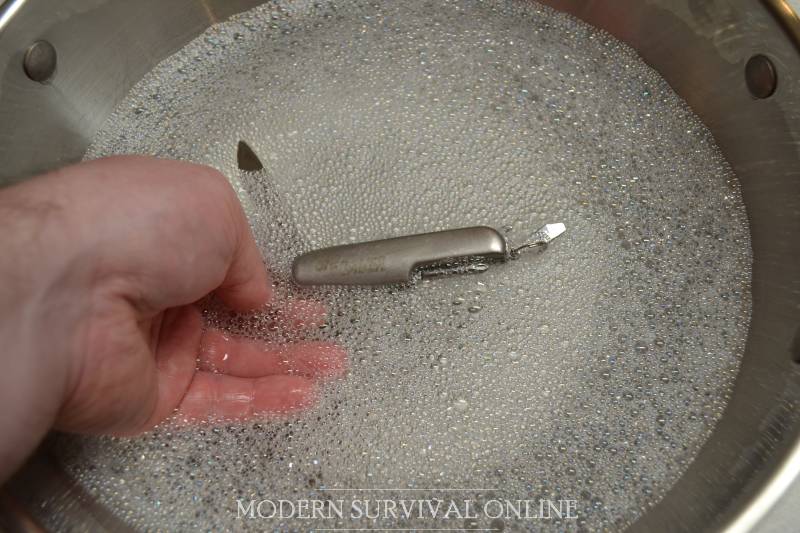
The alternative method is to open as many tools as you can on the knife before immersing the knife in the soapy water and swishing it vigorously back and forth. This will flush all of the nooks and crannies with the soapy water.
Once you do this for a few seconds, close the tools and blades before opening the others, and repeating the process.
If your Swiss army knife is long overdue for a cleaning, you should notice the water becoming noticeably darkened along with some dirt and debris bobbing around.
Step #3 – Rinse with Hot Water
Just like doing the dishes, the next step is to rinse your knife. You want to get all soapy residue as well as all loosened grit and dirt out of the knife. You can use the accessory sprayer at your sink or a separate container of water for the purpose.
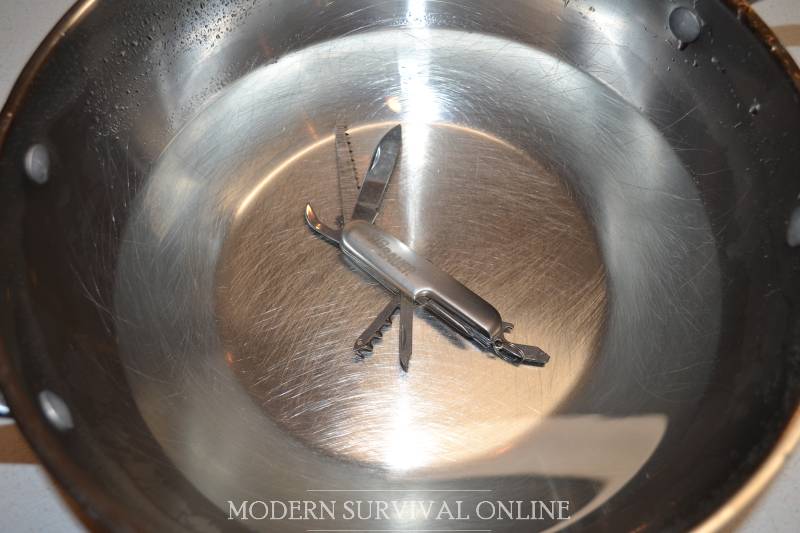
Another tip. Use the hottest water you can stand for this process, as it will do a better job of flushing the soapy residue, and it is also more likely to evaporate out of inaccessible crevices, helping to spare you from the possibility that rust will begin forming should you miss it in the next step.
Step #4 – Blow Out and Dry
This step is positively vital, and you must be thorough. Dry your knife out as well and as thoroughly as you can, preferably using forceful, high-pressure air from any available source.
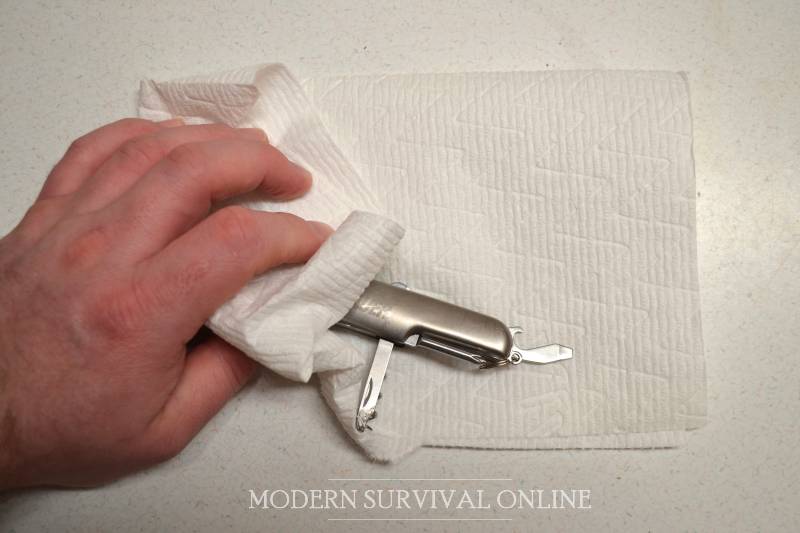
Begin by shaking out the knife as well as you can to flick all the remaining droplets of water off of it and out of the frame. Then, grab your air source.
Keyboard duster cans work as will any workshop air compressor. If you need to improvise, use a leaf blower or stick your Shop-Vac hose on the exhaust port to create an improvised blower.
It is critical you do everything you can to get all traces of water out of the knife, as missing even a little bit can promote rust and you’ll be doing more harm than good.
You don’t need to lose any sleep over this, as you can always place the knife in front of a fan, heat it gently with a hair dryer or even leave it out in the sun to promote thorough drying.
Once you are sure as you can be that the knife is thoroughly dry you can move on to the next step.
Step #5 – Try Tools for Correct Function
It is time to check our work. With the knife dry, open and close every tool and blade on board. They should open and close with greater smoothness than they did before, although they might not feel totally slick because we removed all the old oil and greasy residue from the knife.
Pay attention, and if you notice any gritty or grinding sensations that means there is still likely dirt and debris hiding within the knife.
If that’s the case, repeat the previous two steps before trying this step again and repeat until you are sure the knife is as clean as it can be. Once you have finished, move on to the next step.
Step #6 – Oil
You have cleaned the knife and are satisfied that it is functioning normally. Our penultimate step is to re-lubricate using any quality oil suitable for use on cutlery.
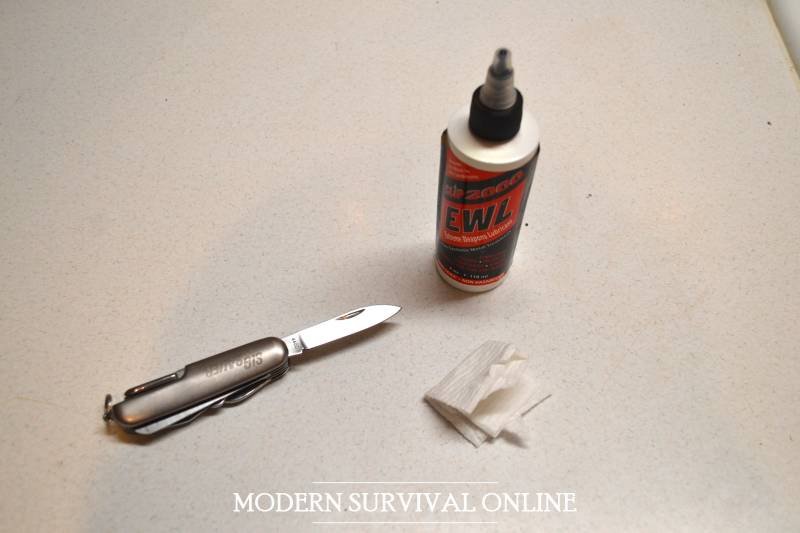
Make sure you lightly lubricate every metal surface on every tool along with the frame. Use a cotton swab if you have to.
Also make sure to apply a drop of oil at the pivot of every tool before opening and closing it a couple of times to distribute. Once again, the tool is going to be slippery and you’ll be working with sharp edges, so be careful!
Only one more step to go and it is as easy as pie.
Step #7 – Re-Mount Scales
The only thing left to do now is remount your scales or handle slabs if your knife uses them. Screw them back on or snap them back into place and then you are done. Wipe off any oily residue on your handle scales for safety.
You are Finished!
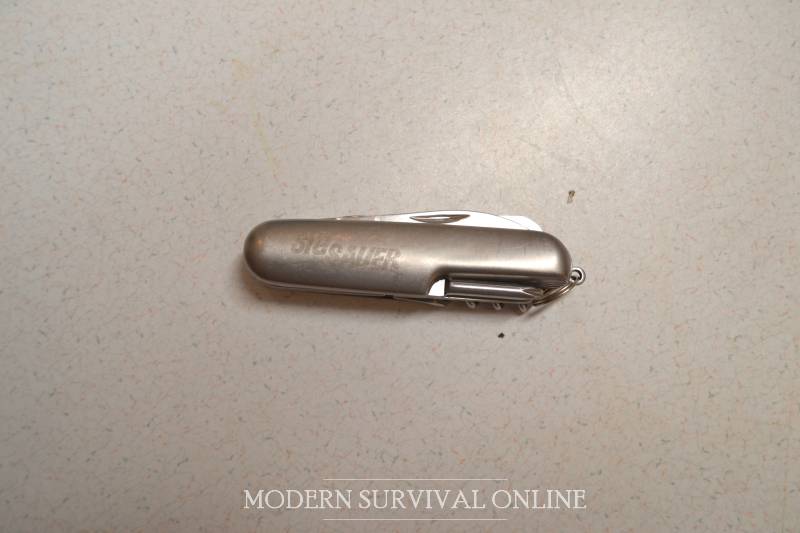
Conclusion
The Swiss army knife is a cherished and time-tested multi-tool that has served generations of adventurers and preppers and will serve generations more.
These compact and ultra portable multi-purpose tools have much to commend them, but they are challenging to clean properly and safely using the wrong technique.
You won’t have that problem, since you learned a foolproof and simple technique in this article! If your Swiss army knife is overdue for a cleaning you shouldn’t waste any more time- break out the soap and oil and take care of it!
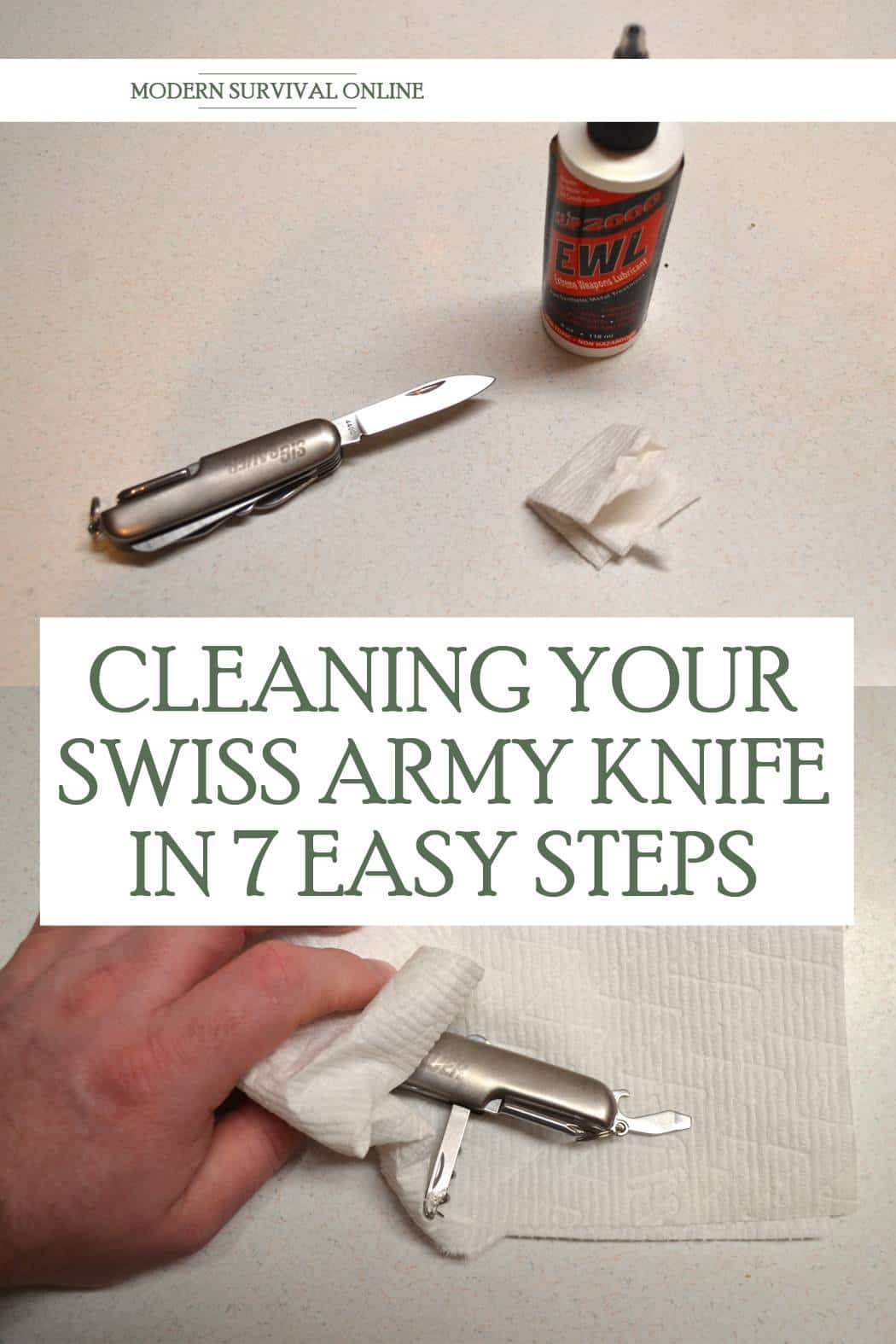
via Modern Survival Online https://ift.tt/3w4GWnO
No comments:
Post a Comment